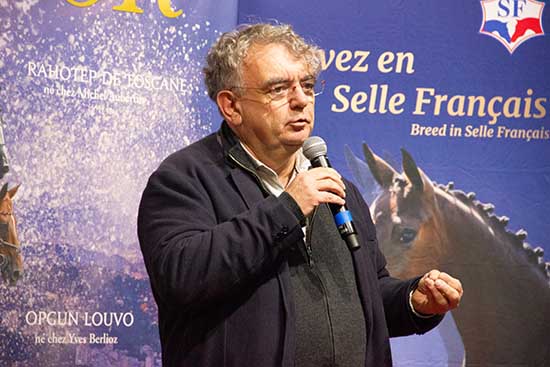
By Jean Llewellyn / press release
Photography: Les Garennes
On December 18, 2019, the Selle Français symposium took place, during the first day of testing, at the Saint-Lô horse racing center. This conference was marked by the presentation of a new tool for breeders: the Stallion Statistical Sheets, created by Margot Sabbagh (IFCE) and Benoît Chaigne (Stud-Book Selle Français), together with geneticist Anne Ricard who explained the methodology and the results of the characterization programs for gaits, model, and free jumping.
This was followed by a seminar on genomics: the state of play in equines and in other species, potential contributions in the selection of sport horses; presented by Anne Ricard and Albéric Valais, breeder of French Trotters and director of Selection Organizations La Normande and Rouge des Prés. Finally Albéric Valais presented a smartphone application, T.E.A.M. Genetics Trot, a crossover aid tool for breeders of French Trotters. This conference was closed with the signing of a partnership between the Stud-Book Selle Français, IFCE and the saddlery company CWD with the aim of continuing the studies carried out on the characterization of sport horses.
(All the presentations are available for viewing on the Selle Français Youtube channel)

Speakers and presentation summaries
Anne Ricard is an agricultural engineer from AgroParisTech. Her entire career has been spent at the National Institute for Agricultural Research (INRA) as a research engineer at the French Institute for Horses and Horse Riding (IFCE). Her first work was the calculation of BSO followed by BDR and BCC and today BRE and BPO: genetic indices for the different sports: show jumping, dressage, eventing, endurance, and ponies, respectively. She studied the genetics of osteochondrosis, sports longevity, reproductive performance or behavior, and created diversity management tools. Today she is seeking to integrate genomics into this work to refine and improve models and selection methods. She is, herself, a breeder of dressage horses.
Anne Ricard’s ‘characterization program’ enabled the objective characterization of gaits, morphology and free jumping. Today 1,000 to 1,500 horses have been measured by accelerometry in walk, trot, gallop, and free jumping, and with three-dimensional anatomical landmarks for morphometry.
The main results show a fairly large independence between pace and conformation on the one hand and performance in showjumping competition on the other hand. This therefore gives these characteristics their place in a selection program which aims to produce a good show-jumping horse, but also a horse with a morphology and gaits adapted to the different categories of rider.
Additionally, the time of suspension during free jumping is very strongly genetically linked to success in show- jumping and makes it a criterion of objective choice for early selection.
In parallel to the previous projects, the horses involved in the characterization have been genotyped, that is to say that we know their DNA bases in more than 400,000 points distributed over the genome. Genomics makes it possible to know the genes having a major effect on characteristics such as coat color or monogenic diseases such as fragile foal syndrome. It also allows for complex characteristics to refine the kinship relationships between horses with the same genealogy and, therefore, to be more precise in the evaluation of their genetic value. The fall in the prices of genotyping techniques used on a large scale makes it possible to hope for the availability of a tool making it possible both to manage congenital malformations, controls of parentage, assignments of parentage, and to improve genetic values. produced, in particular based on the characteristics measured on a small number of horses... To read the complete article you need to be a subscriber
CLICK HERE TO SUBSCRIBE TO BREEDING NEWS
SUBSCRIBERS CAN READ THE COMPLETE ARTICLE BY LOGGING IN AND RETURNING TO THIS PAGE




